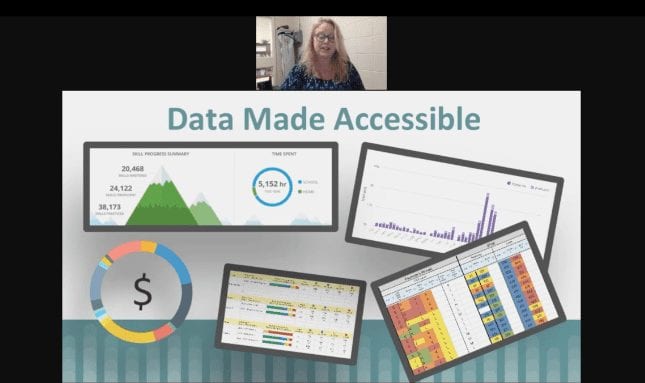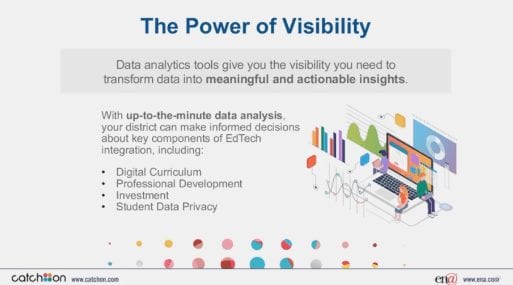How Districts Can Unlock Actionable Data
In a 2018 survey, the majority of school districts either have 1:1 as a current goal or have already achieved it. Along with a 1:1 goal, comes the deluge of edtech tools, software, and applications into classrooms. School districts are struggling with the fact that 70% of purchased licenses for edtech programs don’t get used at all within the school year and only 10% of teachers know how often students should use edtech programs to drive learning outcomes. In a recent edWeb.net edWebinar, Jena Draper, Founder and General Manager of CatchOn; Mike Schwab, Education Team at Google; and Suzy Brooks, Instructional Technology Director for Mashpee Public Schools, MA, point out that in order to combat this deluge of technology, it is imperative that school districts address the tech usage data that impacts and drive success in classrooms. While it is believed that the barrier to district leaders and classroom teachers using more data is that they don’t have time to look at it, 33% of districts and teachers say the real challenge is that information is in too many places for them to access.
Obstacles
Schwab said, “There are many tools out there, but many make it super difficult for schools to see how they are using the tools that they are paying money [for]. This obstacle leads to funds used sub-optimally, which further compounds the problem of underfunded districts.” Brooks states that a common theme amongst school districts that use innovative technologies to promote student-driven learning situations is the duplications of software and applications across school buildings and the lack of centralized funding sources. It was critical that school districts “get a handle on” digital tools and subscriptions in an attempt to streamline and create efficiencies in their districts that can lead to measurable improvements and learning outcomes while balancing student privacy and meeting annual budget.
Data Analytics
Data empowers school districts to make informed technology decisions that impact student success, Draper explains. Data analytics tools give the visibility school districts need to transform data into meaningful and actionable insights. With up-to-the-minute data analysis, districts can make informed decisions about critical components of edtech integration, including digital curricula, professional development, investment, and student data privacy. No matter how much time teachers are given to work in data teams, tables and graphs can be so complicated that they can lose sight of how the data relates to a particular child, specific classroom or grade level. When data is disseminated and understood, stakeholders begin to make recommendations, provide interventions and plan for increasing student performance.
Professional Development
60% of teachers say they need better training to integrate edtech tools and identify the ideal targets for the majority of edtech programs they use in the classroom. Underutilized tools, while not ineffective, do require focused teacher training that makes the most of technology investments. Using data analytics tools, educational leaders can pinpoint resources differences in usage to create targeted professional development and training plans. Also, having access to actual usage data enables district leaders to have meaningful conversations with educators about the impact of digital tools.
Data Privacy
It is imperative that district leaders remain vigilant and mindful of the learning tools used in classrooms. Many developers use open source, standardized privacy policies, and this generic piecemeal approach to student data privacy policies can jeopardize student data. According to The Washington Post, many educational apps become targets when school districts fail to protect student data, often sending personally identifiable information (PII) to third-party advertisers. Using data analytic tools can safeguard student data privacy through the monitoring and tracking of every online resource used in classrooms resulting in compliance with standards defined in the Children’s Online Privacy Protection Act.
This edWeb webinar was sponsored by Education Networks of America (ENA) and CatchOn.
This article was modified and published by EdScoop.
About the Presenters
After 10 years as an elementary teacher, Suzy Brooks is now the director of instructional technology for Mashpee Public Schools in Massachusetts. Additionally, she provides professional development and hands-on workshops for educators at local, regional and national venues. Her work in blended learning, student engagement, and social media has been featured by EdWeek, NBC News’s Education Nation, Instructor Magazine, Intel, ISTE, ASCD, Tech & Learning and the NEA. Currently, Suzy is a visiting lecturer at Fitchburg State University, a MassCUE Pathfinder and the Massachusetts ASCD President. Suzy holds a B.S. from Bridgewater State University and an M.Ed. in instructional technology from Lesley University.
Mike Schwab has spent his career in finance, enterprise software sales and edtech. Given his background in cloud computing and passion for education, he moved to the Google for Education Team in 2012 and was one of the first Chromebooks for Education team members. He has been working ever since to help bring Google for Education solutions to school districts around the country. He is passionate about working with districts as they move to the cloud and increase students’ access to technology.
Jena Draper is the founder and general manager at CatchOn, a company designed to support teaching and learning through the smarter use of data and technology. In 2016, she created CatchOn to help districts meet and adapt to changing instructional needs and trends through the use of real-time data and cutting-edge technology. Jena is passionate about improving how students learn with technology.
About the Host
Monica Cougan joined ENA in 2012, where she currently serves as the product marketing manager. Bringing over 30 years of experience in technology integration, Monica oversees ENA’s partner program and product marketing initiatives. Monica’s prior work with education and the integration of technology in schools and districts, helps guide ENA’s work with education partners offering outstanding programs to schools. She has extensive experience in building collaborative network opportunities specifically videoconferencing and collaborative technologies. Monica continues to support national organizations advocating for the effective use of technology and supporting the needs of our education and library communities.
Join the Community
Leadership and Innovation is a free professional learning community on edWeb.net that serves as an online forum for collaboration on leadership and innovation in schools to meet the needs of the next generation.

CatchOn is a user-friendly data analytics tool that collects real-time data on every device, enabling school districts to make data-informed decisions about the apps and online tools their educators and students are using. In 2018, CatchOn joined forces with ENA, a leading provider of comprehensive technology solutions to education institutions and libraries across the nation. Collectively, CatchOn and ENA leverage their respective resources and expertise to deliver critical services and solutions that help school districts produce positive outcomes in the communities they serve.





Comments are closed.